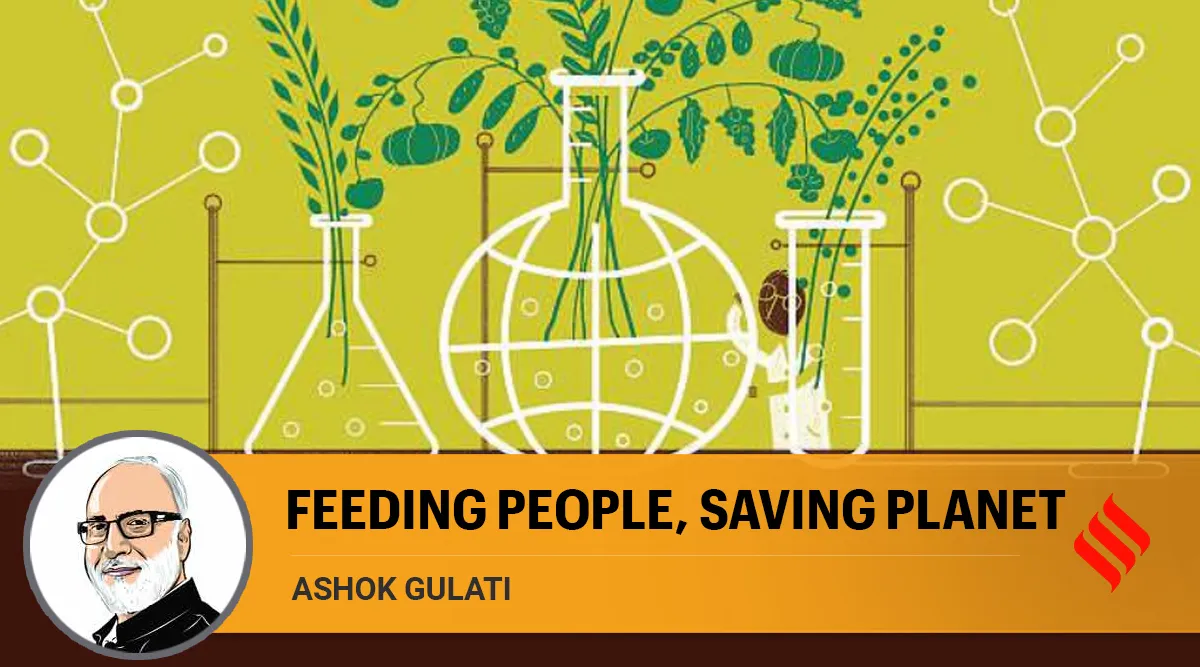 The World Food Prize is given every year on October 16 in a special ceremony in Des Moines, Iowa. (Illustration by C R Sasikumar)
The World Food Prize is given every year on October 16 in a special ceremony in Des Moines, Iowa. (Illustration by C R Sasikumar)October 16 is celebrated as the World Food Day around the world. It is the foundation day of the Food and Agriculture Organisation (FAO) of the United Nations which was set up in 1945. World War II left several nations badly bruised and devastated; the fear of hunger was looming large. Nations thought of establishing the FAO with a global vision to ensure that enough food is produced to feed the increasing population. The global population at that time was a little less than 2.5 billion and was increasing at an annual rate of about 1.9 per cent per annum. Today, there are almost 8 billion people on this planet, and there is ample food to feed them — if they have the money to buy it. Access to food at affordable prices, however, remains a challenge for a substantial segment of humanity — which leads to malnutrition.
Still, we can rejoice that homo-sapiens, who learned practising agriculture only 10,000 to 12,000 years ago — in their long journey going back to as much as 2,00,000 to 3,00,000 years — have been able to produce so much food that the entire global population can be fed. This speaks of the success of science and innovations in the agri-food space. Countries that are guided by scientific knowledge and the spirit of innovation, instead of ideologies and dogmas, have produced ample food, even in deserts — Israel, for example. And many countries have suffered terrible outcomes when they have been driven by ideologies. China is a case in point, when during 1958-61, more than 30 million people died of starvation during Chairman Mao Zedong’s “Great Leap Forward”. Mao wanted to transform China from an agrarian society to a commune-based system of communist ideology. His project was a miserable failure, causing extreme hardships to millions of people. It was Deng Xiaoping, in 1978, who ushered in reforms in Chinese agriculture by dismantling the commune system.
Under Jawaharlal Nehru’s leadership, India, the second most populous country on the planet, also suffered by resorting to a heavy industry-led development strategy as a means to wipe out poverty and become an advanced nation. Two successive droughts in the mid-1960s brought the country literally to its knees for meeting the basic food requirement of its people. India was forced to rely on PL 480 food aid from the USA and had to live from “ship to mouth”. Although it did not have starvation deaths at a scale anywhere near what China suffered, India soon realised such high dependence on others for food could lead to political compromises.
The technological breakthrough in high-yielding varieties (HYV) of wheat by Normal Borlaug and his team in CIMMYT, and Henry Beachell and Gurdev Khush in rice at IRRI, ensured that humanity can have plenty of the basic staples. As is well known, Borlaug received the Nobel Prize for peace in 1970, as there is no Nobel Prize for Agriculture, for saving millions of lives through scientific research. He envisioned setting up the World Food Prize, somewhat equivalent to the Noble Prize for Agriculture. It was established in 1986 and was sponsored by General Foods, the John Ruan family and many others.
The World Food Prize is given every year on October 16 in a special ceremony in Des Moines, Iowa. I have participated in these events, and can safely say that the almost week-long programme to showcase advances in agriculture science, policies and programs have often been eye-openers. Indians including M S Swaminathan, Verghese Kurien, Gurdev Khush and Rattan Lal have been recipients of the prize.
Lately, the focus has shifted from just augmenting food production to nutrition and climate resilience. This year’s award went to Cynthia Rosenzweig for her pioneering work in modelling the impact of climate change on food production. Nothing can be better timed than developing tools to understand the impact of climate change when climate shocks are already knocking on our doors with higher frequency and intensity of heat waves, droughts and untimely floods, putting millions at risk of food security.
Interestingly, while agriculture gets severely impacted by climate change, it also leads to almost 28 per cent of the global greenhouse gas (GHG) emissions thus contributing to global warming. So, it is time to invest not only in climate adaptation strategies but also re-work our policies that can mitigate GHG emissions for agriculture. The net zero carbon target seems to be ambitious. Though a bit late, it can serve humanity well, if sincerely implemented and this planet can still feed more than 10 billion people.
But changing the behaviour of people cannot be achieved in a business-as-usual scenario. One has to work on policies that incentivise people to change their way of doing things, be it in agriculture or in any other field. Today, there seems to be a lack of sync between policies and technologies. It is high time for India to wake up, and double or even triple its expenditure on agri-research and development and education. Currently, it hovers around 0.6 per cent of the agri-GDP for the Centre and states combined. This needs to go up to at least 1 per cent, and, preferably between 1.5 to 2 per cent of the agri-GDP. Only then India can be self-reliant (atmanirbhar) in food even in the face of adverse climate change.
In the meantime, on this World Food Day, let us commit to giving our best to this planet as well as catering to people’s basic needs for food. At ICRIER, we are bringing out our October issue of Af-TAB (Agri-food trends and analytics bulletin) on synergising food and nutritional security with the environment. Stay tuned.
Gulati is Distinguished Professor at ICRIER. Views are personal